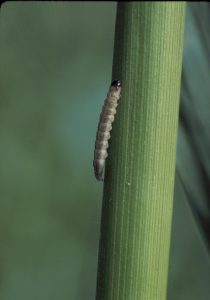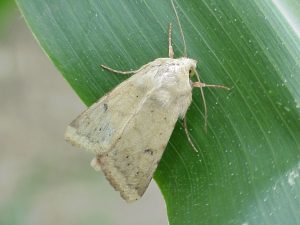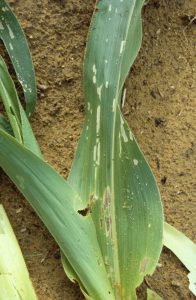Sweet Corn IPM Newsletter No. 1 — June 29, 2023
2023 SWEET CORN PEST SEASON BEGINS!
European Corn Borer Active in Early Fields, Earworm Reported in Massachusetts
The 2023 University of Maine Cooperative Extension Integrated Pest Management (IPM) program for sweet corn is getting underway. We have set up pheromone traps at volunteer farms to monitor the adult (moth) stages of European corn borer, corn earworm and fall armyworm, and have begun scouting the fields for feeding injury by insect larvae. We’ll share the information we collect along with management recommendations through this newsletter. It will also be posted on the Highmoor Farm web page blog. If you would prefer to receive this newsletter via e-mail, give us a call at 207.933.2100 or send an e-mail message to david.handley@maine.edu.
Situation
Early planted corn under plastic mulch or rowcovers is approaching silk in the southern part of the state, but most later planted corn has suffered from the excessive rain and cool temperatures, which has slowed development. The heavy rains have also led to leaching of fertilizer and herbicides, so maintaining adequate fertility and weed control may be more challenging than usual. Corn insect monitoring programs in New York and Massachusetts are reporting captures of European corn borer and corn earworm. This suggests that activity will begin soon in Maine, and growers with early corn at pre-tassel or beyond should initiate scouting for the presence of these pests.

European corn borer: Pheromone traps for moths are set up in the grassy borders around cornfields. New York and Massachusetts are reporting significant corn borer flights. We have found larval feeding damage in some whorl to pre-tassel corn in southern Maine, but not yet at levels over the control threshold. To monitor corn borer feeding, we examine 100 corn plants in each field, typically twenty plants in a row at five different locations. This provides a good estimate of the total amount of injury in a field.
In the early stages, European corn borer feeding damage looks like small “pinholes” in the leaves. Whorl stage corn only needs to be sprayed if fresh feeding injury is found on 30% or more of the plants scouted. Once the corn reaches the pre-tassel stage, the control threshold is lowered to 15% because larvae feeding at this stage are more likely to move into the ears. On the tassels, feeding damage first appears as chewing and brown waste found in the small florets. After the tassel has emerged from the whorl, the larvae chew into the stalk just below it, often causing the tassel to fall over. Sprays during the pre-tassel stage, when both moths and larvae are present, target the larvae before they can move into the protection of the stalks and ears. Good spray coverage of the entire plant provides the most effective kill of larvae as they move from one part of the plant to another. Rotating the type of insecticide used also improves control. Materials registered for controlling European corn borer include Bacillus thuringiensis products (XenTari®, Dipel DF®), Avaunt®, Coragen®, Warrior II®, Lannate®, Baythroid®, Asana®, Radiant®, Delta Gold®, Mustang®, Sevin XLR® and Intrepid®. Newly hatched European corn borer larvae are very small and translucent with shiny black heads. They emerge from small egg masses that look like a tiny clump of overlapping fish scales on the undersides of corn leaves. European corn borer overwinters in Maine and is usually the first pest to become a significant problem.
Growers should start scouting whorl to pre-tassel stage corn for feeding injury now. Once corn reaches the silk stage, sprays may be based on the number of corn borer moths caught in pheromone traps rather than feeding injury. European corn borer moths will lay eggs on flag leaves of silking corn, and the larvae can move into the ears without leaving visible feeding injury that would be noticed when scouting. If more than five moths are caught during a week in a field with silking corn, a spray is recommended. Varieties of corn genetically modified to produce the Bt toxin (e.g. Bt corn, Attribute® varieties), shouldn’t need to be sprayed for European corn borer.

Corn earworm: We have set up pheromone traps around the state for corn earworm moths this week. Corn earworm generally appears in Maine in early July, but the actual date varies greatly. New York and Massachusetts sites are reporting corn earworm moths in pheromone traps this week, so we may see moths in Maine soon. The arrival of this pest is only a concern for fields with corn in the silk stage. Fields not yet in silk do not need to be protected from corn earworm. When corn earworm moths are caught at a site, all silking corn in the fields should be protected with a spray. These moths lay eggs on the fresh silks, and the larvae move directly into the ears of corn. When corn earworm moths cannot find silking corn to deposit their eggs on, they may lay eggs on the leaves or tassels of younger corn. The larvae will feed on the foliage and tassels, similar to armyworm, until the ears become available. This damage should be counted, along with any borer or armyworm damage, to determine if a spray is warranted. In many states, corn earworm larvae have become resistant to IRAC group 3A insecticides, e.g. Mustang, Brigade, Hero, Warrior, Asana, Pounce, Declare, Delta Gold, Fastac, Baythroid. It is recommended that these products should not be used alone to control CEW. Combining them with another material from a different IRAC group (e.g. Lannate or Blackhawk/Radiant) will improve effectiveness.

Fall armyworm: This is usually the last corn insect pest to arrive in Maine. The moths fly in from southern overwintering sites and tend to lay their eggs on the youngest corn available. The young larvae chew large, ragged holes in the leaves, and may bore into developing ears. Larvae can also move into the ears through the silk channel, behaving similarly to corn earworm. Pheromone trap catches will indicate if there is a threat to silking corn. However, corn is often on a spray program for corn earworm when fall armyworm is present, and both insects should be controlled. There have been no reports of fall armyworm yet in New England.
Squash vine borer moths were caught in pheromone traps in Massachusetts this week, indicating that egg laying will begin soon. Squash vine borer moths are black and orange and resemble wasps. They lay their eggs at the base of squash plants. The larvae bore into the base of the plants, causing vines to wilt and collapse. Growers should be on the lookout for vine borer symptoms and protect squash plants if moths or damage are seen. See the New England Vegetable Management Guide for control options.
Potato leafhopper alert: We expect leafhoppers will soon be active in vegetable and berry fields. These small, bullet-shaped insects feed on plant sap from the undersides of leaves, causing the leaves to become curled, stunted and yellow-streaked. Beans are often the first crop to show symptoms, but other crops are also susceptible, including potatoes, peppers, eggplant, strawberries and raspberries. To scout for leafhoppers, brush the leaves of the plants with your hand. The small, whitish adults can be seen flying off the plant. Look for small, light green leafhopper nymphs on the underside of injured leaves. They are about 1/16 inch long. When touched, they will crawl sideways in a crab-like manner. Control options for potato leafhoppers are listed in the New England Vegetable Management Guide.
Do-It-Yourself IPM: To get the most accurate information about the pest situation on your farm you should monitor the fields yourself on a regular basis. Pheromone traps and lures are available that can give you an accurate, early warning of the arrival of all of the major insect pests. Traps and lures can be purchased from pest management supply companies such as Gempler’s (1.800.382.8473) or Great Lakes IPM (517.268.5693). You may also want to download a copy of our fact sheet Managing Insect Pests of Sweet Corn.
Sincerely,
David T. Handley
Vegetable & Small Fruit Specialist
Highmoor Farm
P.O. Box 179
52 U.S. Route 202
Monmouth, ME 04259
207.933.2100
UMaine Extension Diagnostic
Research Lab, Pest Mgmt. Unit
17 Godfrey Drive
Orono, ME 04473
1.800.287.0279
Where brand names or company names are used, it is for the reader’s information. No endorsement is implied nor is any discrimination intended against other products with similar ingredients. Always consult product labels for rates, application instructions and safety precautions. Users of these products assume all associated risks.
The University of Maine is an equal opportunity/affirmative action institution.
